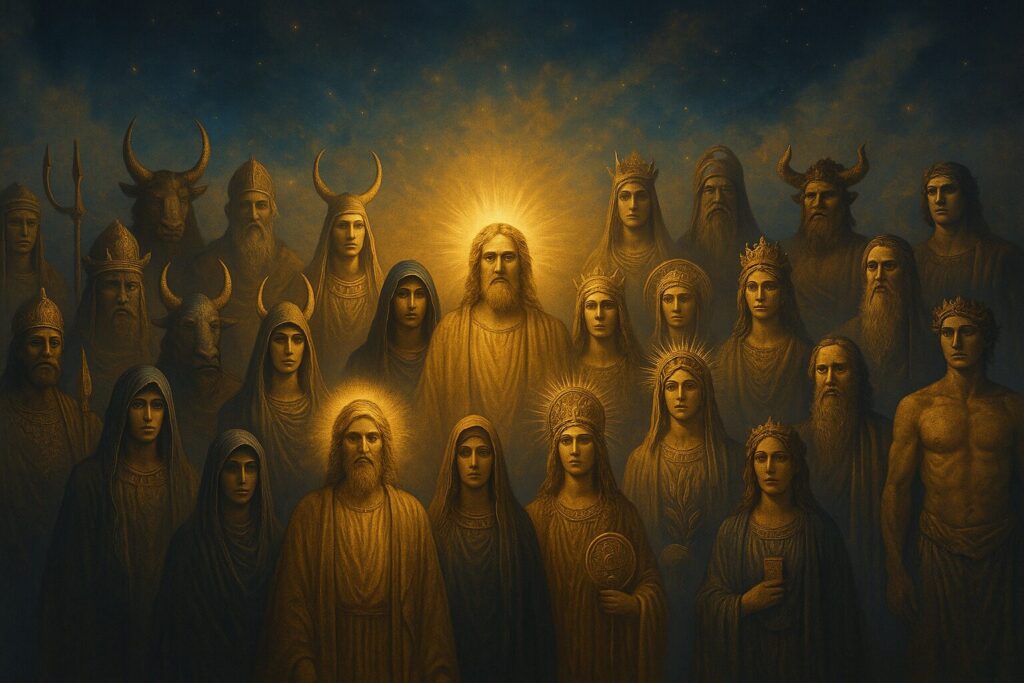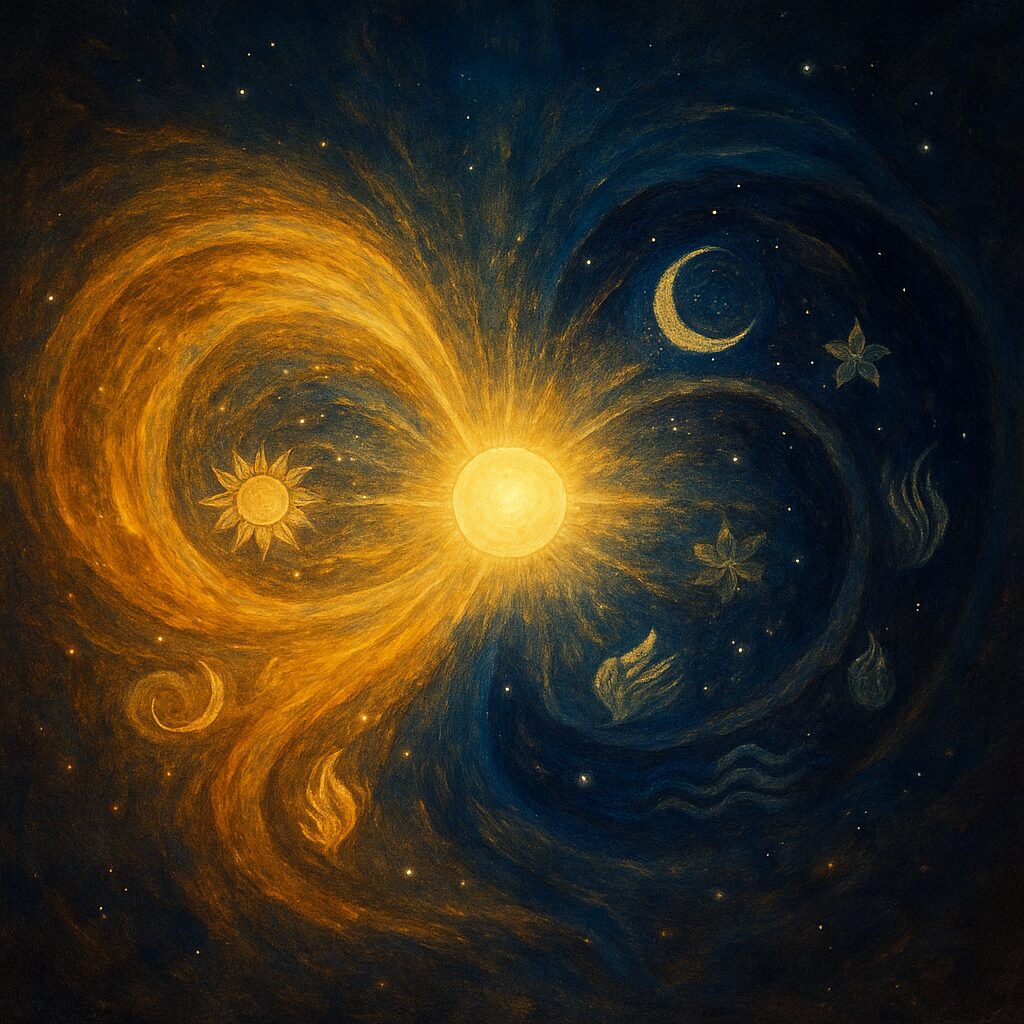The Path of the One: When the Many Dream Themselves as One

The history of the sacred moves like breath—an endless rhythm of dispersal and return. In one age the divine appears in a thousand faces: gods of river and hearth, of war and birth, of dream and decay. In another, the faces merge into one ineffable countenance. Polytheism exhales, monotheism inhales. Yet the air is the same. Every theology is the atmosphere of its time—no less sacred for its limitations, no less human for its reach. What we call “monotheism” is not the antithesis of Paganism but one of its many metamorphoses: a dream in which the Many imagined themselves as One, only to wake again into plurality.
In the deep past, the world was bound to place. Deities were local, embodied in grove, mountain, and ancestor. The earliest city-temples of Sumer and Canaan housed families of gods, each with domain and lineage. But as empires rose—Babylonian, Persian, Egyptian, Israelite—the need for cosmic order mirrored the need for political order. The great unity of heaven was the reflection of the king’s consolidation on earth. A single throne demanded a single god. Thus, monotheism was born not from revelation alone but from administration: the metaphysics of empire. Yet its soil remained polytheistic, rich with older roots.

Even the earliest monotheisms betray their plurality. In the Hebrew Bible, Yahweh stands among the divine council—the Elohim—presiding as high god among peers. Older strata of the text still echo with other presences: Asherah, once the Mother of the Grove; El Elyon, the Most High, who parceled the nations among his sons; the “hosts of heaven” whose worship was later condemned. These were not metaphors, but memories. The move from henotheism to exclusivity was slow, and the traces of the older gods survived like fossils within the bedrock of scripture. They were not destroyed; they were reclassified—gods renamed as angels, powers demoted to servants, rivals recast as demons. The pantheon was not abolished but domesticated, disciplined into hierarchy.

So too in Christianity, where the Trinity—Father, Son, and Spirit—reinstates triadic divinity under a single Name. The saints form a communion of localized powers, their intercession no different from the patronage once sought from Athena or Brigid. The Virgin Mary, crowned with stars, is the ancient Great Mother transfigured into Christian light. Islam, perhaps the purest assertion of unity, declares “there is no god but God,” yet fills heaven and earth with angels, prophets, and the Ninety-Nine Names—each a radiant aspect of the One. Even Zoroastrianism, often cited as monotheism’s dawn, speaks through duality: Ahura Mazda opposed by Angra Mainyu, attended by the amesha spentas and yazatas, beings of light who echo the old Indo-Iranian devas. Sikhism venerates the One beyond all names, yet proclaims that all names are His. The so-called singularities of faith are never singular. They are theologies of focus, not ontologies of exclusion. Devotion narrows its gaze; the cosmos remains multiple.

Philosophy, meanwhile, reintroduced what dogma denied. Plotinus spoke of the ineffable One from whom emanates the Nous, and from the Nous, Soul, and from Soul, the world—a chain of being indistinguishable from divine family. In Gnostic vision, the pleroma unfolds in aeons, each an idea become person, until the Demiurge—the craftsman—creates the material realm without understanding the Source. Beneath orthodox confession, cosmology once again blossoms into plurality. Even within Christianity, the Logos and the Spirit are intermediaries of a metaphysical hierarchy. The archons of Gnostic lore, the celestial intelligences of Islamic philosophy, the Kabbalistic sefirot descending from Ein Sof—all these reveal that multiplicity is not a heresy against unity, but its inevitable language. The One, when it truly overflows, becomes the Many.

The psychological consequence of this transformation was profound. In the polytheist world, the divine was relational—one negotiated, propitiated, and celebrated the gods as neighbors in a living cosmos. With monotheism came a new interiorization: one no longer bargained but obeyed. The relationship became vertical rather than horizontal. The One God demanded faith over familiarity, purity over participation. As Nietzsche observed, the moralization of nature replaced the celebration of it. Jung later read this as a repression of the psyche’s own pantheon: the gods, driven inward, reemerged as archetypes and complexes, saints and demons of the unconscious. The old gods never died; they migrated into the self. What had been divine multiplicity became psychological multiplicity. Monotheism conquered Olympus only to enthrone it within the human mind.

Pagan thought answers this not by denial but by reframing. There is indeed a unity at the root of being—but it is not personal, not jealous, not possessive. It is the Source beyond duality, the dark radiance before creation. From that unmanifest fullness arises motion, polarity, the dance of difference. The One becomes Two, the Two become Many. Light and shadow, male and female, order and chaos: each is sacred because each is necessary. To honor the Many is to honor the One through its manifestations. To worship only the One is to mistake the seed for the tree. Monotheism identifies the first voice that spoke; Paganism listens for the chorus that followed.

Mystics within the monotheisms have always approached this same realization. Ibn ‘Arabi wrote that God is the mirror in which we see ourselves, and every form is a theophany. Meister Eckhart spoke of the Godhead beyond God, the silent abyss that births divinity anew each moment. Hildegard of Bingen sang of viriditas, the greening power of life in all things. The Kabbalists saw creation as a river of divine emanations, each sefirah both distinct and united in the endless outflow of Ein Sof. These are Pagan intuitions wearing monotheist garments. They remind us that unity, when understood deeply, is plural at its core. Only tyranny demands that the world worship one face alone.

For all its beauty, monotheism has too often been weaponized. “One God, one truth, one law” mirrored “one empire, one ruler, one order.” The suppression of rival gods paralleled the suppression of rival peoples. The feminine was diminished; the earth desacralized. Where Paganism saw the divine in every spring and storm, monotheism often saw property—a creation to manage rather than a kinship to honor. Even secular modernity inherits this grammar of singular mastery: reason as god, progress as creed, humanity as center. The theology of the One became the politics of control. Against that, Paganism rises again not to destroy faith but to remind it of its forgotten plurality—to teach once more that holiness is participatory, not proprietary.

For the Coven of the Veiled Moon, we hold that all gods are true, though none are complete. The deities of monotheism are authentic emanations, and we do not deny them; we contextualize them. Monotheism, to us, is a subset of polytheism—a single note within the larger chord. We see the One not as king but as current, the flow of being through all things. Every spirit, every god, every grain of earth carries that current.
Let no one mistake our reverence for contempt. The monotheist vision has carried light, justice, and compassion into the world. Yet when that light hardens into judgment, it blinds rather than illumines. To call another’s gods false is to forget that all names are borrowed from silence. Paganism’s task is not to convert but to remember—to reawaken the mutuality between heaven and earth, self and cosmos, the seen and unseen. The divine is not elsewhere. It has always been here, dreaming through the Many, reflecting itself in the eyes of every being.
The path of the One is, in truth, the path of the Many returning to themselves. The god who speaks from Sinai or Mecca or Rome is kin to the one who whispers in oak and riverbed. The difference lies not in essence but in emphasis. When the One dreams, it dreams in countless forms; when the Many awaken, they remember the dream. To live in harmony with that rhythm is to stand again within the sacred weave—to breathe the old breath of creation, where unity is not command but communion, and every god is a doorway into the same unfathomable light.

Live your earthly life fully, but try to see the spiritual aspects of your activities as well. Remember—the physical and spiritual are but reflections of each other.”
— Scott Cunningham, Wicca: A Guide for the Solitary Practitioner
